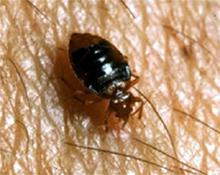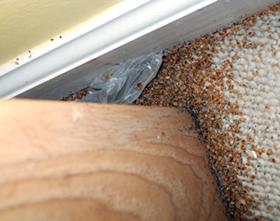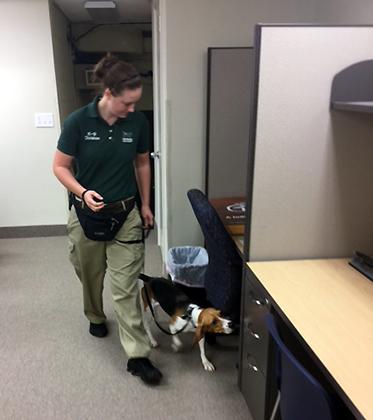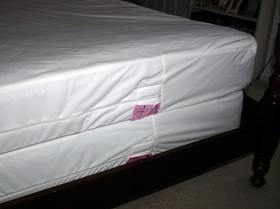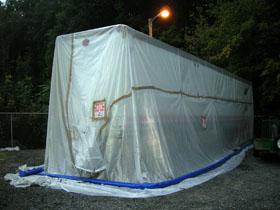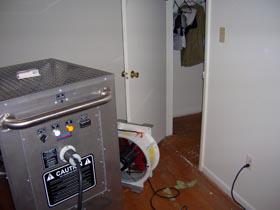Bedbugs have become a common problem across the country infestations showing up in residences, hotels, college campuses and other places. Many people associate bedbugs with unsanitary conditions, as often is the case with pests such as cockroaches. However, bedbug infestations occur across the spectrum of social and economic settings. Experts have speculated that the increase is more likely due to a number of factors such as increased travel and tourism, changes in tactics used for controlling pests such as cockroaches, and an increasing resistance by bedbugs to the most commonly used insecticides.
Our primary concern is with the “common” bedbug, Cimex lectularius. Another species in the bedbug family (Cimicidae), Cimex hemipterus, is usually found in more tropical areas and may show up particularly for people engaged in international travel. A number of other species are more frequently associated with birds and bats but on occasion invade homes.
Identification
Bedbugs adults are reddish-brown, oval, flattened insects about 3⁄16 long and up 1⁄8 wide (Figure 1). Engorged (blood-fed) adults are swollen and dull red. Though wingless, adult bedbugs do have small wing pads. The dark-colored eyes stand out and the sides of the collar-like pronotum curve slightly around the head and is covered with long hairs. The nymphs (immatures) resemble the adult but are smaller in size. Newly hatched nymphs are almost colorless whereas engorged (blood-fed) nymphs are reddish and swollen. Bedbug eggs are white, oval eggs about 1 mm long.
Life Cycle and Habits
Although humans are the preferred host, bedbugs feed on many warm-blooded animals including rats, mice, dogs, cats, poultry, and other birds. Bats, swallows, and chimney swifts may serve as hosts and may be responsible for causing infestations in or around buildings but they are more typically fed upon by other species in those situations.
There has been no scientifically-based evidence showing that bedbugs transmit diseases. Our major concern is more about the affect of their feeding. Bedbugs do not bore into the skin. They insert their mouthparts into the host's skin and suck out blood. As bedbugs feed, they inject saliva which may produces an allergic reaction that often causes slightly delayed swelling, itching, and irritation that can persist for a week or more. Large infestations of bedbugs may have a noticeable "sweet" odor.
Bedbugs can feed and breed year round under favorable conditions. They typically hide during the day in mattresses or cracks and crevices. Figure 2 shows a bedbug and fecal stains in a mattress seam. Under favorable conditions, each female lays 200 to 500 eggs. When the insects feed regularly, eggs are laid in batches of 10 to 50 at 3 to 15-day intervals. Maximum egg laying occurs when the temperature is above 70°F (21°C). Eggs are typically not deposited when temperatures drop below 50°F (10°C). The eggs are coated with a sticky substance that dries after the egg is deposited and causes the eggs to adhere to the object on which they were deposited. Eggs and the eggshells are found, singly or in clusters, in or near the crevices bedbugs are hiding. At temperatures above 21°C (70°F), eggs hatch in about 10 days. At lower temperatures, hatching may take as long as 28 days.
Newly hatched bugs feed at the first opportunity. They molt five times before reaching maturity and require at least one blood meal between each molt. Immature stages can survive more than two months without feeding; however, most nymphs usually develop into adults within 2 to 6 weeks. Indoors, three or four annual generations may be produced and you will find all stages of bedbugs in an established infestations. Bedbug adults can survive up to a year or more without feeding, which means that infestations may continue to survive even if a house was left vacant for several months.
Bedbugs cannot fly or jump and do not normally crawl long distances. Their primary means of dispersal is through human activity, i.e., people move them from one place to another in luggage, laundry, etc. Animals, particularly birds and bat, may be involved in bed / bat bug dispersal. Piles of cast nymphal skins often accumulate in bedbug hiding places. Figure 3 shows piles of shed skins at the base of bed headboard.
Eliminating Bedbugs
STEP ONE - confirm that you do have bedbugs. Bedbug bites often leave a reddish slightly swollen welt that can resemble a mosquito bite but typically last longer. Some people do not react as severely. The bites may be in a pattern of 3-4 in a row (depending on the number of bedbugs present and how a person lies on a mattress). However, a bedbug problem cannot be reliably identified solely on the basis of welts or other seemingly insect-related bite marks. It is critical to find actual evidence of the bedbugs: actual insects, shed skins, fecal spots, etc. as shown Figure 2 and Figure 3.
Most of our infestations have been true bedbugs, but on occasion we have had bat bugs and swallow bugs which are difficult to distinguish without a microscope or high magnification lens. A pest control service may be able to help you or you can contact your local county Cooperative Extension center. If you do have bat bugs, check attics, eaves and roof overhangs for signs of bat. If you have bats roosting in your attic, contact a pest control company or wildlife damage control company in your area for assistance. Although most of our bedbug problems are not associated with birds or bats, it's always a good idea to confirm that they are not the source of an infestation or other potential problems. Remove old nesting material as well.
STEP TWO - locate all of their hiding places
- Furniture, particularly bedroom furniture must be inspected carefully (Figure 4). Bedbugs may crawl 10-20 feet; so don't limit your search only to the bed.
- When possible, dismantle the bed for easier inspection and possible treatment. Inspect the mattress and box spring thoroughly. Be sure to check the holes or slots where sections such as the sides, head and foot boards attach.
- Check under and behind other pieces of furniture, particularly chairs and couches that are frequently used (Figure 5 and Figure 6). Don't forget dressers, nightstands, closets, etc.
- Pull out dresser drawers, inspect them carefully and check the interior of the dresser before reinserting the drawers.
- Check the undersides of lamps, clocks, radio, phones and other objects that might be on nightstands.
- Pull back the dust covers on the undersides of chairs and couches and check particularly around the legs and frame.
- Remove the covers on electrical outlets and switches and inspect the boxes for signs of bedbugs.
- Check obvious cracks and crevices along baseboards.
- Remove and inspect objects, such as pictures, mirrors, curtains, etc., that are hung or mounted on walls.
- Inspect torn or loose wallpaper and decorative borders.
- Check all clothing and other items stored in areas where bedbugs have been found.
- If you have traveled in the last few months, inspect your luggage as well as the entire closet/storage area (and its contents) where you store your luggage.
- Some pest control companies offer the services of a specially-trained dog to detect bedbugs (Figure 7). We are not endorsing their services specifically, but they can be very cost-effective particularly for large multi-unit properties (hotels, assisted-living facilities, dormitories, etc.). As with any pest control service, make sure you understand the terms and any guarantees before you sign any contracts. The dog handler or his employer must be licensed by the North Carolina Department of Agriculture & Consumer Services. Be a smart consumer and ask about how the dog was trained (e.g., was the training conducted by someone qualified for training dogs in such detection work).
STEP THREE - CONTROL
Chemical Control
The next step is to treat bedbug hiding places and his requires work on your part There a many products available for bedbug control. Many people prefer to use less toxic "natural" products; however, most of these chemicals work strictly as contact insecticides, i.e., they must be applied directly to the insects in order to kill them and there is no residual effect meaning that once the chemical dries it will not affect other bedbugs that come into contact with it. Other insecticides leave a residual that remains active for weeks or months after they’re applied. READ THE PRODUCT LABEL TO MAKE SURE YOU UNDERSTAND HOW THE PRODUCT WORKS. Some products are applied as surface sprays (to exposed surfaces) while other treatments are applied only as "crack and crevice" to gaps around baseboards and other such areas and items where bedbugs hide. Insecticidal dust formulations such as diatomaceous earth, silica gel, and more common dust insecticides provide longer residual in these locations. Not all dust products are available to the general public and care is needed when applying them to avoid inhaling the product while applying it. Pesticide applications to furniture, particularly mattresses, should be limited (and perhaps best left to a pest control professional).
Many pest control services now recommend (or require) that treated mattresses and box springs be placed inside sealable casements (Figure 7) that prevent bedbugs from escaping the treatment and also keep other bedbugs from re-infesting the items. When treating furniture for bedbugs make sure you use only products that are labeled for application to these items. You can click on the following links for examples of pesticides available to the general public and pest management professionals. Always read the label and follow directions and safety precautions. Here are some important reminders about using pesticides:
- Never use insecticide products that are intended for outdoor use only or for agricultural use. They pose a serious risk to your health.
- Never apply chemicals at higher rates (amounts or concentrations) or more frequently that what is listed on the product label. Overapplying pesticides will not improve control but it can endanger your health.
- Seeing live bedbugs 1-2 days after treating does not necessarily mean that the insecticide is not working.
- In most situations, a single application does not seem to give complete or immediate control. Additional treatments may be needed in 7-14 days (depending on the product). In some cases, a third or fourth treatment may be needed particularly if all infested sites have not been identified or if becomes apparent that the bedbugs are resistant to the chemical(s) being used.
For extreme or difficult infestations, fumigation may be used. Fumigation is not the same as using a "fogger" (total release aerosol). Foggers are not effective in eliminating bedbug infestations. Fumigation uses a toxic gas and you must either seal the entire house (or entire apartment building) or place furniture and other items into an isolated container (e.g., a panel truck or steel storage container) and sealed for treatment (Figure 9). Fumigating an entire house (or apartment) may require that the entire building be covered with a tarpaulin (or completely sealed) in order to treat it. Fumigation will kill all of the bedbugs and is an alternative to other insecticide applications if an entire house is infested; however, it leaves no residual (killing) insecticide.
Non-Chemical Control
Some people prefer to dispose of infested mattresses and other furniture rather than deal with treating them. It is important to dispose of these items properly. First, you must wrap the items in plastic sheeting before carrying it outdoors so your bedbugs do not crawl onto you or drop off indoors unseen which may further spread the infestation. Second, whether you live in a house or an apartment building, never put infested furniture or clothing at the curb or next to a dumpster (Figure 9) (if allowed) without first rendering it unusable (e.g., cutting the fabric). Otherwise, someone may take the items which only spreads the bedbug problem further. If you replace infested items, do not bring them into the house until you know you have the problem under control or else these new items will become infested. Clothing and some other items that are infested (or suspected of being infested) can be washed in hot water (or follow the tag on the article); however, washing alone will not always kill bedbugs and their eggs. Heat (drying in clothes dryer on ‘high’ for about 30 miinutes or until dry) will kill them. Other items may require dry cleaning which can become an expensive option. Simply isolating clothing or other infested items in trash bags may work but remember that bedbugs can survive for more than six months without feeding.
Physical barriers such as double-sided tape on the legs of beds can help keep bedbugs from crawling onto the frame. There are also commercial traps available online that claim to stop bedbugs from migrating onto beds from surrounding areas. However, none of these barriers will help unless you keep bedspreads, blankets, etc. from touching the floor and providing bedbugs with an "alternate route" onto the bed. Keep in mind that these physical barriers help but they are not a fix for bedbug infestation.
Many pest control companies now offer freezing and / or steam treatments for some types of infested furniture such as mattresses and box springs. Another control method that has proven to be effective is heat treatment. This requires that all of the suspected items or in many cases the entire living area be sealed and heated for several hours to > 120°F (Figure 10). Heat treatments are not simply a matter of raising the air temperature. The heated air must penetrate all areas of the room / house in order to kill bedbugs that are hiding in household articles, in furniture or clothing, or even in walls. Excessive heating can damage furniture, electronics, and other items and may even start a fire if not done properly
The best approach to dealing with bedbugs combines both chemical and non-chemical methods in order to provide a greater likelihood of control. However, even with the use of fumigation, heat and/or conventional insecticides, there is currently no treatment method that can prevent bedbugs from being reintroduced into and reinfesting a home or any other building.
Protect Yourself from Infestations
You never know when and where you might pick up bedbugs. Higher priced hotels or vacation rental properties are no less susceptible to getting bedbugs, but they often have budgets that accommodate more preventive approaches. However, even with the best preventive efforts, almost any property can become home to these hitchhiking pests. The key is to be attentive and prevent the problem from becoming worse. Here are some measures you can take to reduce the likelihood of a problem:
- Check your room carefully, particularly looking for signs of bedbug activity on the mattress or headboard.
- Keep luggage off the floor and check shelves before placing luggage on them (Figure 11). You can keep your luggage inside a trash bag during your stay.
- Upon returning home, empty your luggage on sheet so you can check items carefully (and then wash and dry the sheet).
- Be careful about furniture and other items picked up at yard sales. Avoid buying used mattresses and / or box springs unless unless they have a tag showing that they were sterilized by a state-certified bedding sanitizer.
Other Pest Information
Publication date: June 30, 2018
Recommendations for the use of agricultural chemicals are included in this publication as a convenience to the reader. The use of brand names and any mention or listing of commercial products or services in this publication does not imply endorsement by NC State University or N.C. A&T State University nor discrimination against similar products or services not mentioned. Individuals who use agricultural chemicals are responsible for ensuring that the intended use complies with current regulations and conforms to the product label. Be sure to obtain current information about usage regulations and examine a current product label before applying any chemical. For assistance, contact your local N.C. Cooperative Extension county center.
N.C. Cooperative Extension prohibits discrimination and harassment regardless of age, color, disability, family and marital status, gender identity, national origin, political beliefs, race, religion, sex (including pregnancy), sexual orientation and veteran status.

